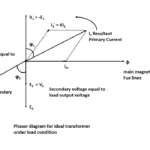This article will explain in detail about efficiency of transformer under various conditions. As we know that efficiency is most important criteria in all equipments. This efficiency determines performance of a machine. Also defines about how it is useful for practical applications
Definition of efficiency
Efficiency of a equipment generally said as ratio of output power supplied to the input power given
Efficiency η = Output power / Input Power
We also may think that why output power is always less than input power supplied to it. Because there are certain amount of losses takes inside the equipment
So it can be written as input power = output power + Losses
Efficiency of a transformer is defined as ratio of input power given to the output power supplied to the load
Efficiency η = Output Power / Input Power
Efficiency η = Output Power / (Output Power + Losses)
Since output power of the transformer is less than input power, efficiency of transformer is always falls between 0 to 1. In other words efficiency of transformer always will be in range of 0% to 100%
If transformer efficiency is 100% , Then it will be equal to 1. It indicates ideal transformer. Because ideal transformer has zero losses
Efficiency of the transformer under different load condition
A Transformer is always is not operating under constant load condition. The following picture shows how efficiency differs in different load conditions. When load increases , efficiency also increases up to certain load levels. After that particular load level , efficiency start to decreases. This is due to , that certain load level , losses of transformer is also increases rapidly. The power losses (i.e. copper losses) is always proportional to square of load current flowing through winding. Hence the efficiency decreases after reaching the maximum value.

Efficiency at full load condition
The output power of transformer at full load = PFL = V2I2CosΦ2 Watts
Generally transformer is always rated in KVA. So above equation may be written as PFL =( KVA x CosΦ2 x 1000) Watts
Let full load copper loss Pcu (FL) and iron loss by Pi then efficiency of transformer

The above equation indicates KVA rating and copper loss Pcu(FL) will change with load. However iron loss always constant with any load condition. The copper loss always changes in proportion in square of load current
Efficiency at half load condition

Efficiency of transformer with frequency
The copper loss of transformer is not depends on frequency . But iron loss is always depends upon the supply frequency. So when frequency increases, iron losses also increases and vice versa.
Conditions for maximum efficiency
Let consider transformer secondary side to determine efficiency of transformer. Because more copper loss taking in secondary winding , while comparing with primary winding of transformer.
Let take total resistance represented in secondary side as R—2
Then copper loss takes in place of secondary side = I22 R—2
Substitute is equation of efficiency of transformer

Dividing both neumerator and denominator by I2

If secondary voltage V2 is considered as constant for constant power factor Cos Φ2 , we will get maximum efficiency equation, when denominator in minimum value.
When derivative of denominator with respective to I2 is minimum



The above equation clearly indicates that,
when iron loss of transformer is equal to copper loss it operates in maximum efficiency
Load at maximum efficiency
Let denote as transformer is operating in full load condition as KVAmax and at particular load condition as KVAload
Pi = Iron losses at any load condition. Because it is constant always while frequency remains constant
Pcu(FL) = Copper loss at full load condition. It is varies with different load condition
Let write copper loss at particular load condition

This is because the copper loss is depends on KVA2
We know that condition of maximum efficiency is
Copper loss = Iron loss


Important design consideration of transformer with efficiency
A transformer is always operates under different load condition. But a transformer will operates with maximum efficiency beyond 75% of load. But it is must that transformer always operates at maximum load condition always. So transformer always designed to operates near full load with maximum load condition













